Healthcare Promotion - Risk of Smoking and COPD
VerifiedAdded on 2022/09/05
|15
|4416
|19
AI Summary
Contribute Materials
Your contribution can guide someone’s learning journey. Share your
documents today.
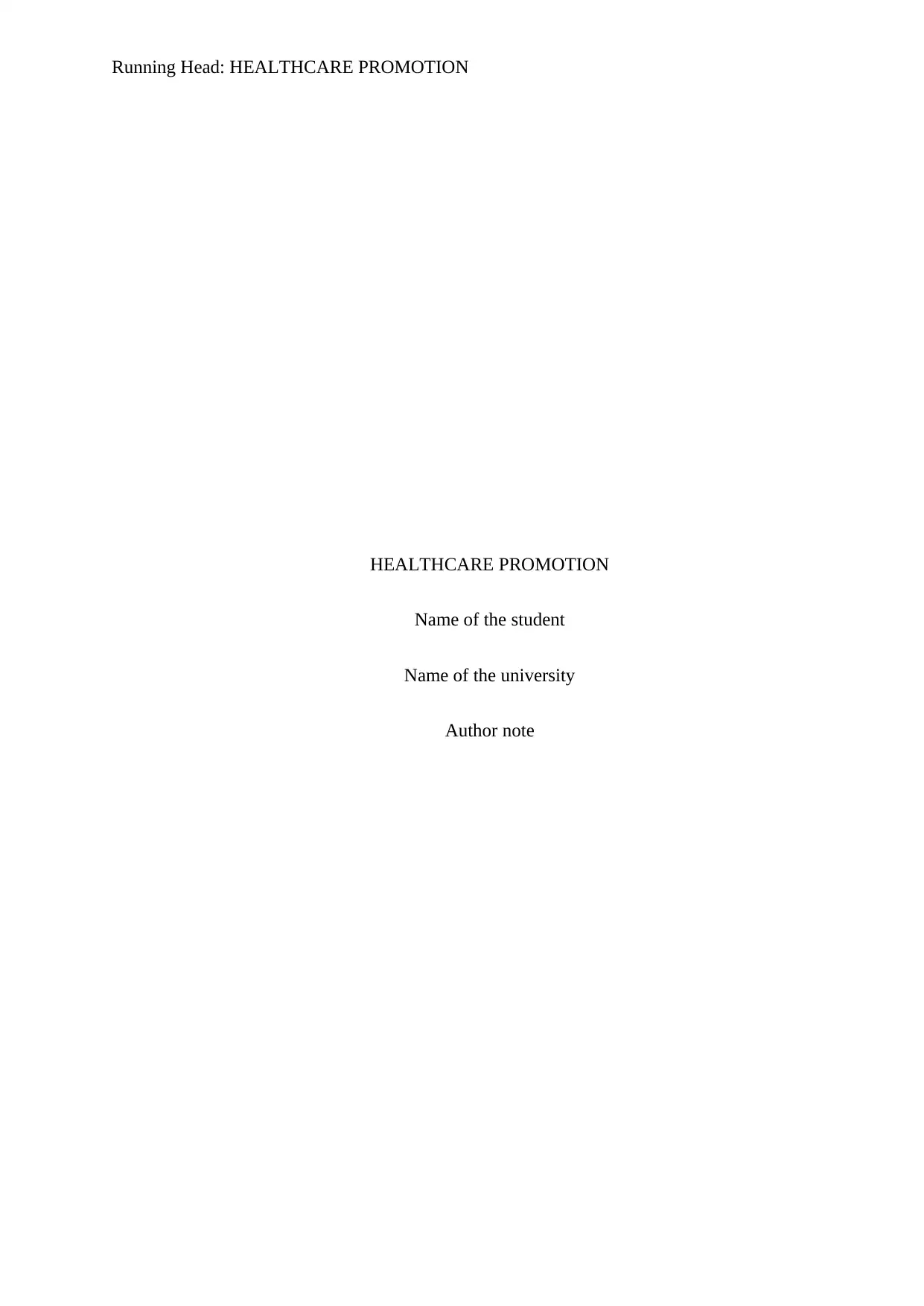
Running Head: HEALTHCARE PROMOTION
HEALTHCARE PROMOTION
Name of the student
Name of the university
Author note
HEALTHCARE PROMOTION
Name of the student
Name of the university
Author note
Secure Best Marks with AI Grader
Need help grading? Try our AI Grader for instant feedback on your assignments.
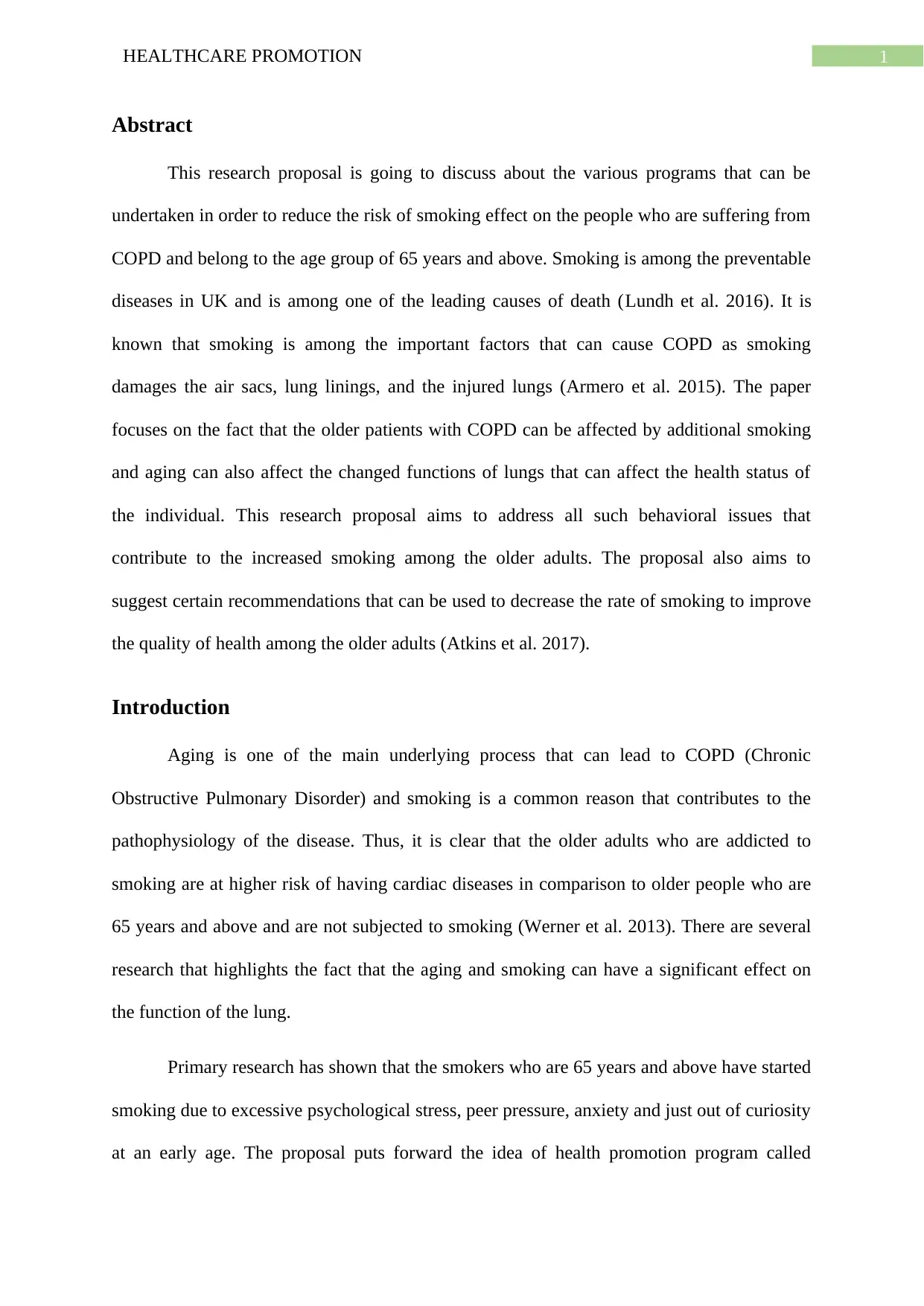
1HEALTHCARE PROMOTION
Abstract
This research proposal is going to discuss about the various programs that can be
undertaken in order to reduce the risk of smoking effect on the people who are suffering from
COPD and belong to the age group of 65 years and above. Smoking is among the preventable
diseases in UK and is among one of the leading causes of death (Lundh et al. 2016). It is
known that smoking is among the important factors that can cause COPD as smoking
damages the air sacs, lung linings, and the injured lungs (Armero et al. 2015). The paper
focuses on the fact that the older patients with COPD can be affected by additional smoking
and aging can also affect the changed functions of lungs that can affect the health status of
the individual. This research proposal aims to address all such behavioral issues that
contribute to the increased smoking among the older adults. The proposal also aims to
suggest certain recommendations that can be used to decrease the rate of smoking to improve
the quality of health among the older adults (Atkins et al. 2017).
Introduction
Aging is one of the main underlying process that can lead to COPD (Chronic
Obstructive Pulmonary Disorder) and smoking is a common reason that contributes to the
pathophysiology of the disease. Thus, it is clear that the older adults who are addicted to
smoking are at higher risk of having cardiac diseases in comparison to older people who are
65 years and above and are not subjected to smoking (Werner et al. 2013). There are several
research that highlights the fact that the aging and smoking can have a significant effect on
the function of the lung.
Primary research has shown that the smokers who are 65 years and above have started
smoking due to excessive psychological stress, peer pressure, anxiety and just out of curiosity
at an early age. The proposal puts forward the idea of health promotion program called
Abstract
This research proposal is going to discuss about the various programs that can be
undertaken in order to reduce the risk of smoking effect on the people who are suffering from
COPD and belong to the age group of 65 years and above. Smoking is among the preventable
diseases in UK and is among one of the leading causes of death (Lundh et al. 2016). It is
known that smoking is among the important factors that can cause COPD as smoking
damages the air sacs, lung linings, and the injured lungs (Armero et al. 2015). The paper
focuses on the fact that the older patients with COPD can be affected by additional smoking
and aging can also affect the changed functions of lungs that can affect the health status of
the individual. This research proposal aims to address all such behavioral issues that
contribute to the increased smoking among the older adults. The proposal also aims to
suggest certain recommendations that can be used to decrease the rate of smoking to improve
the quality of health among the older adults (Atkins et al. 2017).
Introduction
Aging is one of the main underlying process that can lead to COPD (Chronic
Obstructive Pulmonary Disorder) and smoking is a common reason that contributes to the
pathophysiology of the disease. Thus, it is clear that the older adults who are addicted to
smoking are at higher risk of having cardiac diseases in comparison to older people who are
65 years and above and are not subjected to smoking (Werner et al. 2013). There are several
research that highlights the fact that the aging and smoking can have a significant effect on
the function of the lung.
Primary research has shown that the smokers who are 65 years and above have started
smoking due to excessive psychological stress, peer pressure, anxiety and just out of curiosity
at an early age. The proposal puts forward the idea of health promotion program called
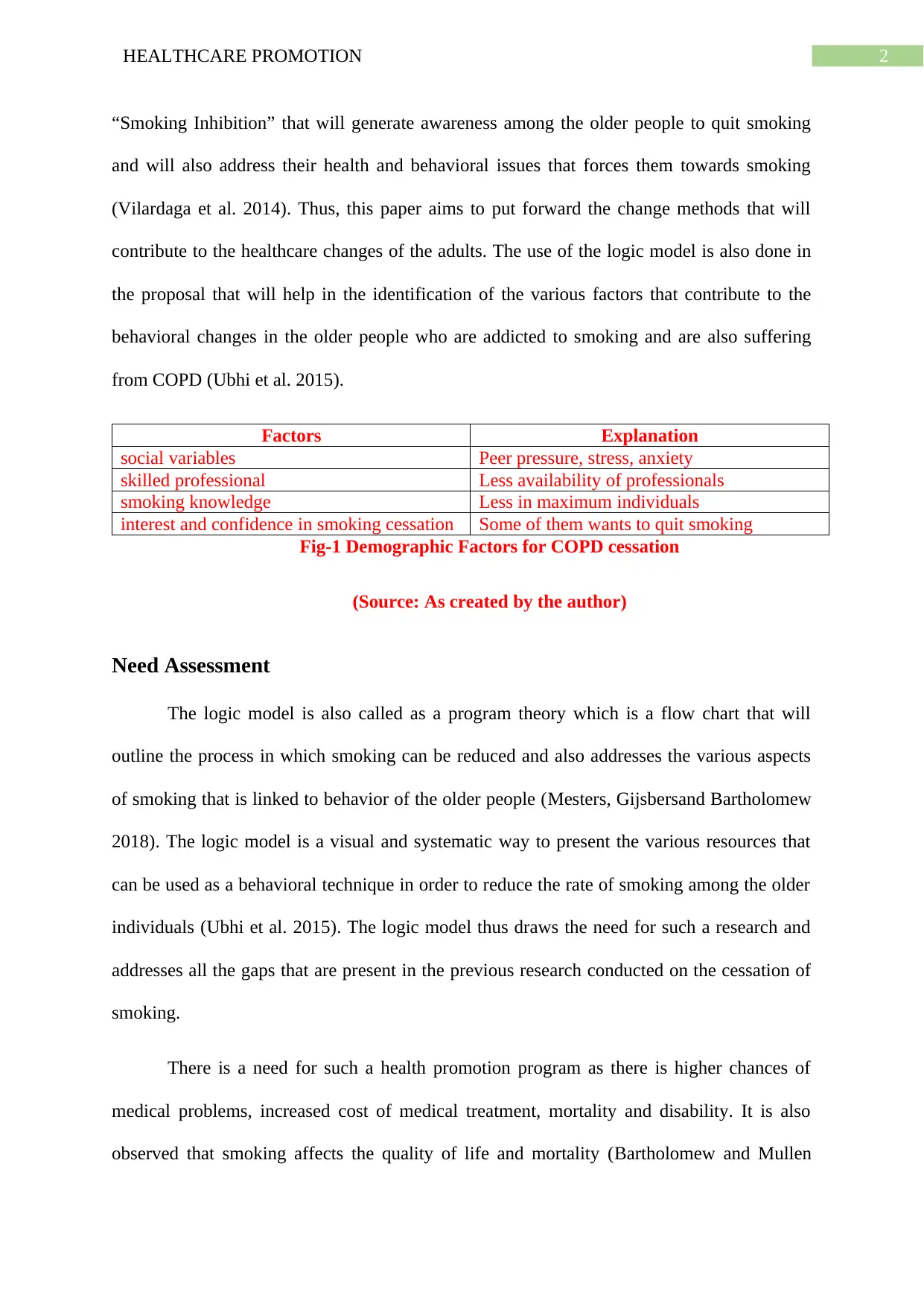
2HEALTHCARE PROMOTION
“Smoking Inhibition” that will generate awareness among the older people to quit smoking
and will also address their health and behavioral issues that forces them towards smoking
(Vilardaga et al. 2014). Thus, this paper aims to put forward the change methods that will
contribute to the healthcare changes of the adults. The use of the logic model is also done in
the proposal that will help in the identification of the various factors that contribute to the
behavioral changes in the older people who are addicted to smoking and are also suffering
from COPD (Ubhi et al. 2015).
Factors Explanation
social variables Peer pressure, stress, anxiety
skilled professional Less availability of professionals
smoking knowledge Less in maximum individuals
interest and confidence in smoking cessation Some of them wants to quit smoking
Fig-1 Demographic Factors for COPD cessation
(Source: As created by the author)
Need Assessment
The logic model is also called as a program theory which is a flow chart that will
outline the process in which smoking can be reduced and also addresses the various aspects
of smoking that is linked to behavior of the older people (Mesters, Gijsbersand Bartholomew
2018). The logic model is a visual and systematic way to present the various resources that
can be used as a behavioral technique in order to reduce the rate of smoking among the older
individuals (Ubhi et al. 2015). The logic model thus draws the need for such a research and
addresses all the gaps that are present in the previous research conducted on the cessation of
smoking.
There is a need for such a health promotion program as there is higher chances of
medical problems, increased cost of medical treatment, mortality and disability. It is also
observed that smoking affects the quality of life and mortality (Bartholomew and Mullen
“Smoking Inhibition” that will generate awareness among the older people to quit smoking
and will also address their health and behavioral issues that forces them towards smoking
(Vilardaga et al. 2014). Thus, this paper aims to put forward the change methods that will
contribute to the healthcare changes of the adults. The use of the logic model is also done in
the proposal that will help in the identification of the various factors that contribute to the
behavioral changes in the older people who are addicted to smoking and are also suffering
from COPD (Ubhi et al. 2015).
Factors Explanation
social variables Peer pressure, stress, anxiety
skilled professional Less availability of professionals
smoking knowledge Less in maximum individuals
interest and confidence in smoking cessation Some of them wants to quit smoking
Fig-1 Demographic Factors for COPD cessation
(Source: As created by the author)
Need Assessment
The logic model is also called as a program theory which is a flow chart that will
outline the process in which smoking can be reduced and also addresses the various aspects
of smoking that is linked to behavior of the older people (Mesters, Gijsbersand Bartholomew
2018). The logic model is a visual and systematic way to present the various resources that
can be used as a behavioral technique in order to reduce the rate of smoking among the older
individuals (Ubhi et al. 2015). The logic model thus draws the need for such a research and
addresses all the gaps that are present in the previous research conducted on the cessation of
smoking.
There is a need for such a health promotion program as there is higher chances of
medical problems, increased cost of medical treatment, mortality and disability. It is also
observed that smoking affects the quality of life and mortality (Bartholomew and Mullen
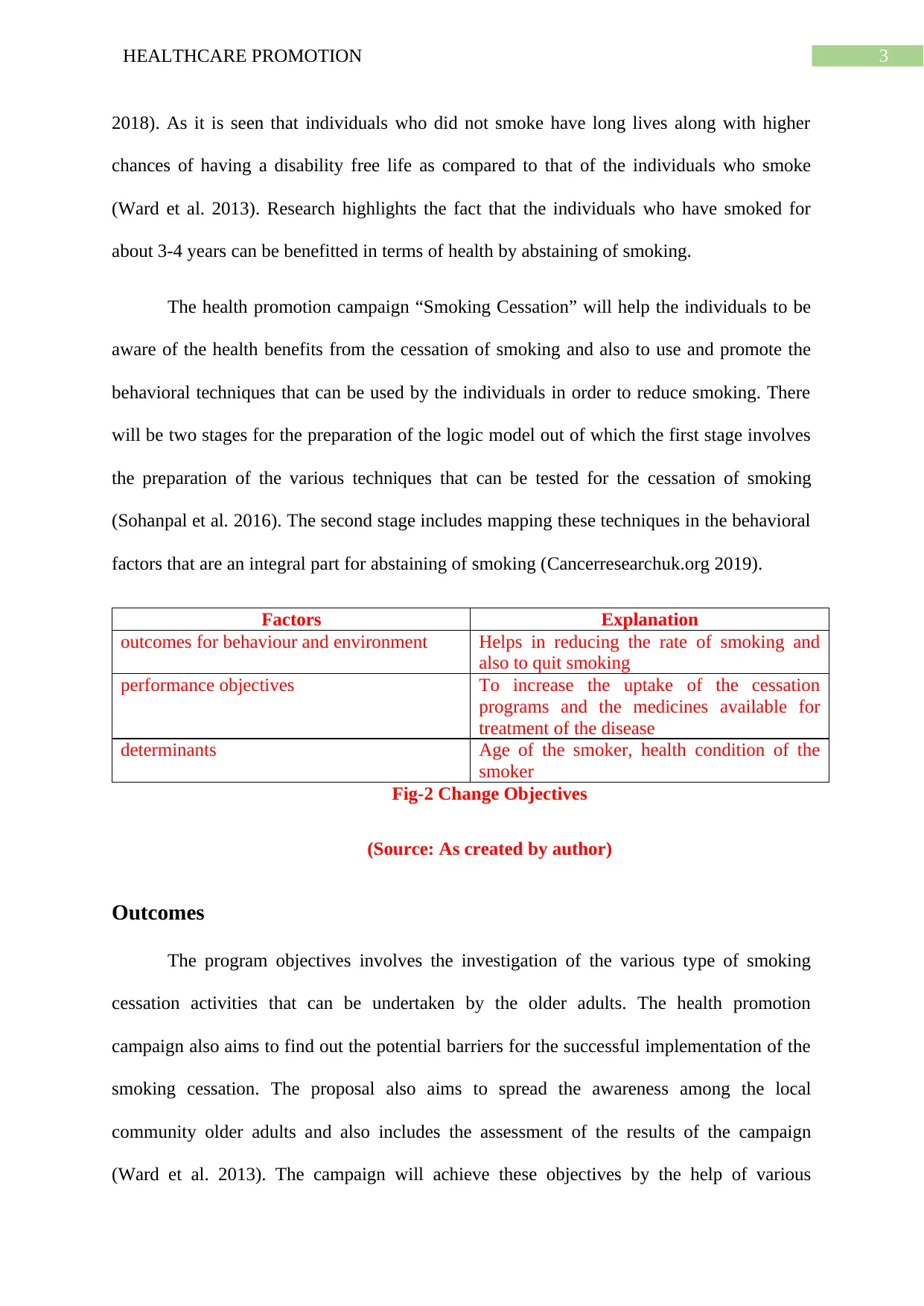
3HEALTHCARE PROMOTION
2018). As it is seen that individuals who did not smoke have long lives along with higher
chances of having a disability free life as compared to that of the individuals who smoke
(Ward et al. 2013). Research highlights the fact that the individuals who have smoked for
about 3-4 years can be benefitted in terms of health by abstaining of smoking.
The health promotion campaign “Smoking Cessation” will help the individuals to be
aware of the health benefits from the cessation of smoking and also to use and promote the
behavioral techniques that can be used by the individuals in order to reduce smoking. There
will be two stages for the preparation of the logic model out of which the first stage involves
the preparation of the various techniques that can be tested for the cessation of smoking
(Sohanpal et al. 2016). The second stage includes mapping these techniques in the behavioral
factors that are an integral part for abstaining of smoking (Cancerresearchuk.org 2019).
Factors Explanation
outcomes for behaviour and environment Helps in reducing the rate of smoking and
also to quit smoking
performance objectives To increase the uptake of the cessation
programs and the medicines available for
treatment of the disease
determinants Age of the smoker, health condition of the
smoker
Fig-2 Change Objectives
(Source: As created by author)
Outcomes
The program objectives involves the investigation of the various type of smoking
cessation activities that can be undertaken by the older adults. The health promotion
campaign also aims to find out the potential barriers for the successful implementation of the
smoking cessation. The proposal also aims to spread the awareness among the local
community older adults and also includes the assessment of the results of the campaign
(Ward et al. 2013). The campaign will achieve these objectives by the help of various
2018). As it is seen that individuals who did not smoke have long lives along with higher
chances of having a disability free life as compared to that of the individuals who smoke
(Ward et al. 2013). Research highlights the fact that the individuals who have smoked for
about 3-4 years can be benefitted in terms of health by abstaining of smoking.
The health promotion campaign “Smoking Cessation” will help the individuals to be
aware of the health benefits from the cessation of smoking and also to use and promote the
behavioral techniques that can be used by the individuals in order to reduce smoking. There
will be two stages for the preparation of the logic model out of which the first stage involves
the preparation of the various techniques that can be tested for the cessation of smoking
(Sohanpal et al. 2016). The second stage includes mapping these techniques in the behavioral
factors that are an integral part for abstaining of smoking (Cancerresearchuk.org 2019).
Factors Explanation
outcomes for behaviour and environment Helps in reducing the rate of smoking and
also to quit smoking
performance objectives To increase the uptake of the cessation
programs and the medicines available for
treatment of the disease
determinants Age of the smoker, health condition of the
smoker
Fig-2 Change Objectives
(Source: As created by author)
Outcomes
The program objectives involves the investigation of the various type of smoking
cessation activities that can be undertaken by the older adults. The health promotion
campaign also aims to find out the potential barriers for the successful implementation of the
smoking cessation. The proposal also aims to spread the awareness among the local
community older adults and also includes the assessment of the results of the campaign
(Ward et al. 2013). The campaign will achieve these objectives by the help of various
Secure Best Marks with AI Grader
Need help grading? Try our AI Grader for instant feedback on your assignments.
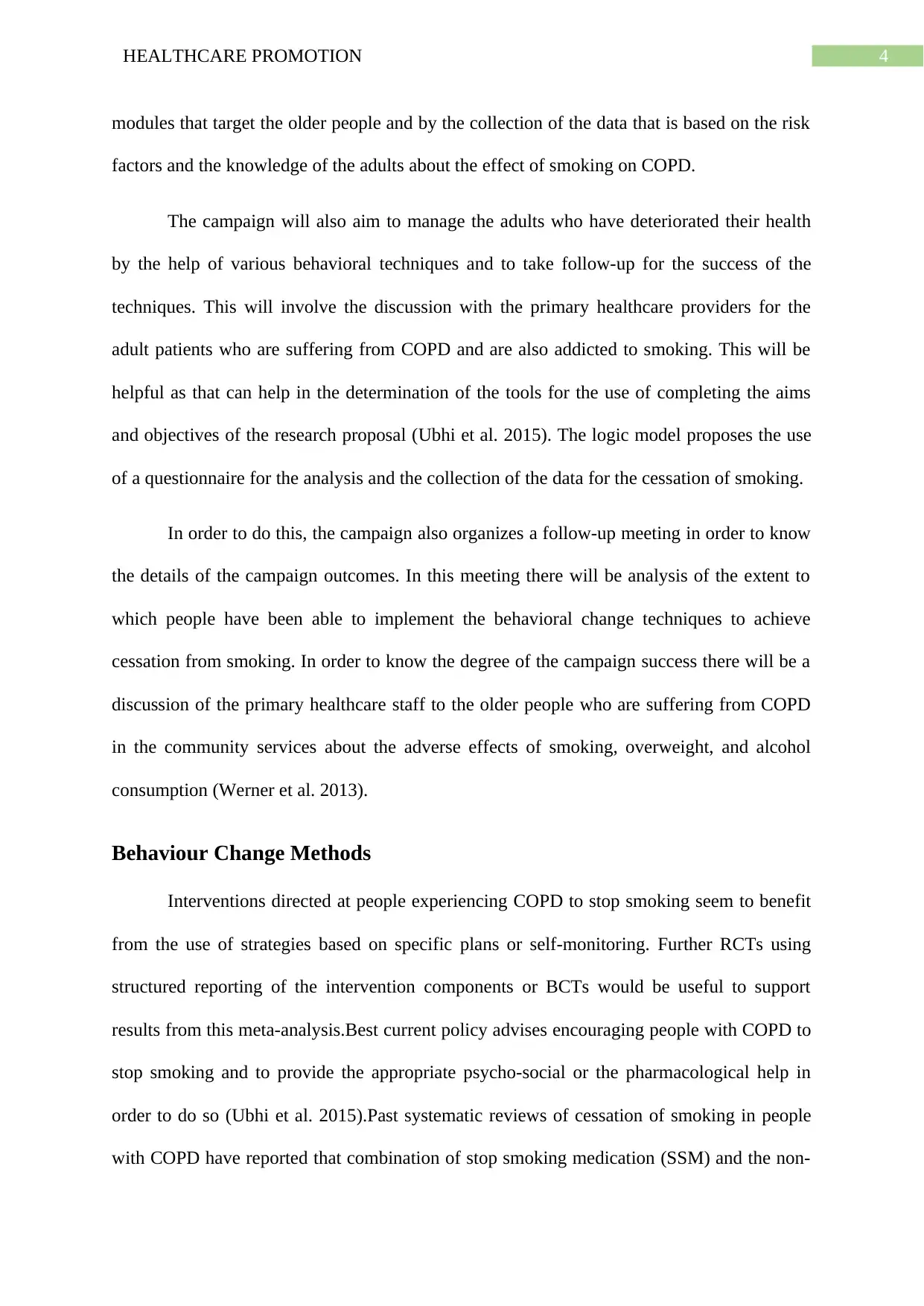
4HEALTHCARE PROMOTION
modules that target the older people and by the collection of the data that is based on the risk
factors and the knowledge of the adults about the effect of smoking on COPD.
The campaign will also aim to manage the adults who have deteriorated their health
by the help of various behavioral techniques and to take follow-up for the success of the
techniques. This will involve the discussion with the primary healthcare providers for the
adult patients who are suffering from COPD and are also addicted to smoking. This will be
helpful as that can help in the determination of the tools for the use of completing the aims
and objectives of the research proposal (Ubhi et al. 2015). The logic model proposes the use
of a questionnaire for the analysis and the collection of the data for the cessation of smoking.
In order to do this, the campaign also organizes a follow-up meeting in order to know
the details of the campaign outcomes. In this meeting there will be analysis of the extent to
which people have been able to implement the behavioral change techniques to achieve
cessation from smoking. In order to know the degree of the campaign success there will be a
discussion of the primary healthcare staff to the older people who are suffering from COPD
in the community services about the adverse effects of smoking, overweight, and alcohol
consumption (Werner et al. 2013).
Behaviour Change Methods
Interventions directed at people experiencing COPD to stop smoking seem to benefit
from the use of strategies based on specific plans or self-monitoring. Further RCTs using
structured reporting of the intervention components or BCTs would be useful to support
results from this meta-analysis.Best current policy advises encouraging people with COPD to
stop smoking and to provide the appropriate psycho-social or the pharmacological help in
order to do so (Ubhi et al. 2015).Past systematic reviews of cessation of smoking in people
with COPD have reported that combination of stop smoking medication (SSM) and the non-
modules that target the older people and by the collection of the data that is based on the risk
factors and the knowledge of the adults about the effect of smoking on COPD.
The campaign will also aim to manage the adults who have deteriorated their health
by the help of various behavioral techniques and to take follow-up for the success of the
techniques. This will involve the discussion with the primary healthcare providers for the
adult patients who are suffering from COPD and are also addicted to smoking. This will be
helpful as that can help in the determination of the tools for the use of completing the aims
and objectives of the research proposal (Ubhi et al. 2015). The logic model proposes the use
of a questionnaire for the analysis and the collection of the data for the cessation of smoking.
In order to do this, the campaign also organizes a follow-up meeting in order to know
the details of the campaign outcomes. In this meeting there will be analysis of the extent to
which people have been able to implement the behavioral change techniques to achieve
cessation from smoking. In order to know the degree of the campaign success there will be a
discussion of the primary healthcare staff to the older people who are suffering from COPD
in the community services about the adverse effects of smoking, overweight, and alcohol
consumption (Werner et al. 2013).
Behaviour Change Methods
Interventions directed at people experiencing COPD to stop smoking seem to benefit
from the use of strategies based on specific plans or self-monitoring. Further RCTs using
structured reporting of the intervention components or BCTs would be useful to support
results from this meta-analysis.Best current policy advises encouraging people with COPD to
stop smoking and to provide the appropriate psycho-social or the pharmacological help in
order to do so (Ubhi et al. 2015).Past systematic reviews of cessation of smoking in people
with COPD have reported that combination of stop smoking medication (SSM) and the non-
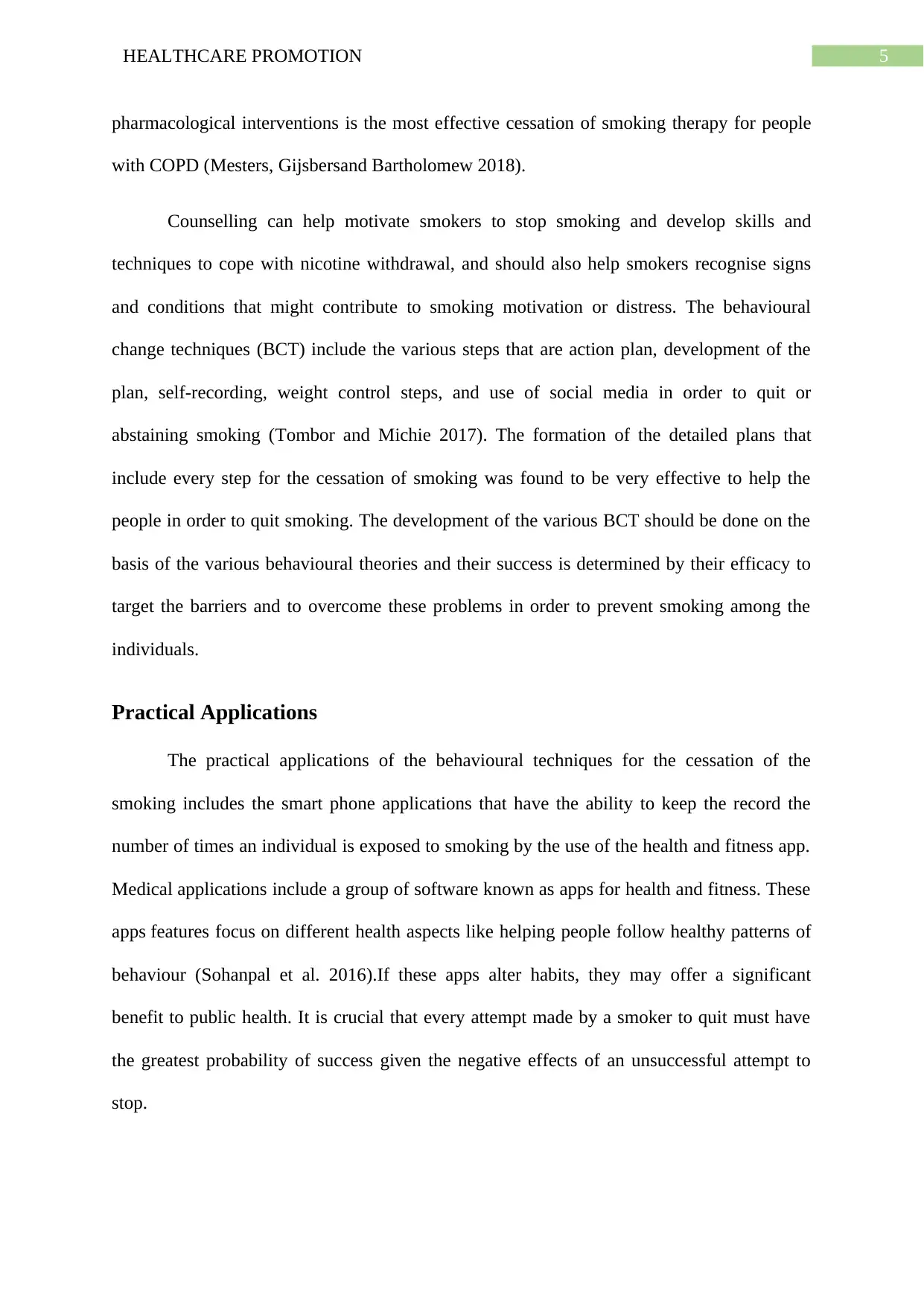
5HEALTHCARE PROMOTION
pharmacological interventions is the most effective cessation of smoking therapy for people
with COPD (Mesters, Gijsbersand Bartholomew 2018).
Counselling can help motivate smokers to stop smoking and develop skills and
techniques to cope with nicotine withdrawal, and should also help smokers recognise signs
and conditions that might contribute to smoking motivation or distress. The behavioural
change techniques (BCT) include the various steps that are action plan, development of the
plan, self-recording, weight control steps, and use of social media in order to quit or
abstaining smoking (Tombor and Michie 2017). The formation of the detailed plans that
include every step for the cessation of smoking was found to be very effective to help the
people in order to quit smoking. The development of the various BCT should be done on the
basis of the various behavioural theories and their success is determined by their efficacy to
target the barriers and to overcome these problems in order to prevent smoking among the
individuals.
Practical Applications
The practical applications of the behavioural techniques for the cessation of the
smoking includes the smart phone applications that have the ability to keep the record the
number of times an individual is exposed to smoking by the use of the health and fitness app.
Medical applications include a group of software known as apps for health and fitness. These
apps features focus on different health aspects like helping people follow healthy patterns of
behaviour (Sohanpal et al. 2016).If these apps alter habits, they may offer a significant
benefit to public health. It is crucial that every attempt made by a smoker to quit must have
the greatest probability of success given the negative effects of an unsuccessful attempt to
stop.
pharmacological interventions is the most effective cessation of smoking therapy for people
with COPD (Mesters, Gijsbersand Bartholomew 2018).
Counselling can help motivate smokers to stop smoking and develop skills and
techniques to cope with nicotine withdrawal, and should also help smokers recognise signs
and conditions that might contribute to smoking motivation or distress. The behavioural
change techniques (BCT) include the various steps that are action plan, development of the
plan, self-recording, weight control steps, and use of social media in order to quit or
abstaining smoking (Tombor and Michie 2017). The formation of the detailed plans that
include every step for the cessation of smoking was found to be very effective to help the
people in order to quit smoking. The development of the various BCT should be done on the
basis of the various behavioural theories and their success is determined by their efficacy to
target the barriers and to overcome these problems in order to prevent smoking among the
individuals.
Practical Applications
The practical applications of the behavioural techniques for the cessation of the
smoking includes the smart phone applications that have the ability to keep the record the
number of times an individual is exposed to smoking by the use of the health and fitness app.
Medical applications include a group of software known as apps for health and fitness. These
apps features focus on different health aspects like helping people follow healthy patterns of
behaviour (Sohanpal et al. 2016).If these apps alter habits, they may offer a significant
benefit to public health. It is crucial that every attempt made by a smoker to quit must have
the greatest probability of success given the negative effects of an unsuccessful attempt to
stop.

6HEALTHCARE PROMOTION
The other applications include very brief advice (VBA) to the individuals who are
addicted to smoking. As smoking tobacco is a learned trait which leads to the majority of
smokers becoming physically addicted to nicotine. Quitting smoking can therefore be
challenging for many people, and approaches should include therapeutic and pharmacological
support (Taylor et al. 2013).When there is encouragement for cessation, brief advice on
the cessation of smoking from a health care professional is successful. This type of guidance,
especially from doctors, causes 1 to 3 smokers out of 100 to quit smoking for minimum 6
months.
Although knowledge and advice on smoking cessation remains relatively consistent
throughout all the approaches, alternative delivery strategies have been established to
promote preference, acceptance, and scope. Choosing a specific delivery mode may be
related to the preferences or availability of an individual and their right to access the action
(Roberts, Kerr and Smith 2013).
Testing Phase
The testing phase of these strategies will include the success rate of the practical
applications. The testing phase will be done on the individuals who are smokers and are
engaged with heavy to moderate smoking. This will be done by the involvement of the
individuals in the age group of 16 to 45 years of age who are either student or working
professionals (Myneni et al. 2015). In order to carry out the tests or analysis approximately
100 individuals will be selected either from schools, colleges or work places.
After the selection of the participants the tests will be carried out by dividing all the
participants into two equal groups. One of the groups will be provided with the smart phone
applications and the other group will be under the VBA. This will continue for 3 months and
then there will be data collection and the analysis of the results.
The other applications include very brief advice (VBA) to the individuals who are
addicted to smoking. As smoking tobacco is a learned trait which leads to the majority of
smokers becoming physically addicted to nicotine. Quitting smoking can therefore be
challenging for many people, and approaches should include therapeutic and pharmacological
support (Taylor et al. 2013).When there is encouragement for cessation, brief advice on
the cessation of smoking from a health care professional is successful. This type of guidance,
especially from doctors, causes 1 to 3 smokers out of 100 to quit smoking for minimum 6
months.
Although knowledge and advice on smoking cessation remains relatively consistent
throughout all the approaches, alternative delivery strategies have been established to
promote preference, acceptance, and scope. Choosing a specific delivery mode may be
related to the preferences or availability of an individual and their right to access the action
(Roberts, Kerr and Smith 2013).
Testing Phase
The testing phase of these strategies will include the success rate of the practical
applications. The testing phase will be done on the individuals who are smokers and are
engaged with heavy to moderate smoking. This will be done by the involvement of the
individuals in the age group of 16 to 45 years of age who are either student or working
professionals (Myneni et al. 2015). In order to carry out the tests or analysis approximately
100 individuals will be selected either from schools, colleges or work places.
After the selection of the participants the tests will be carried out by dividing all the
participants into two equal groups. One of the groups will be provided with the smart phone
applications and the other group will be under the VBA. This will continue for 3 months and
then there will be data collection and the analysis of the results.
Paraphrase This Document
Need a fresh take? Get an instant paraphrase of this document with our AI Paraphraser
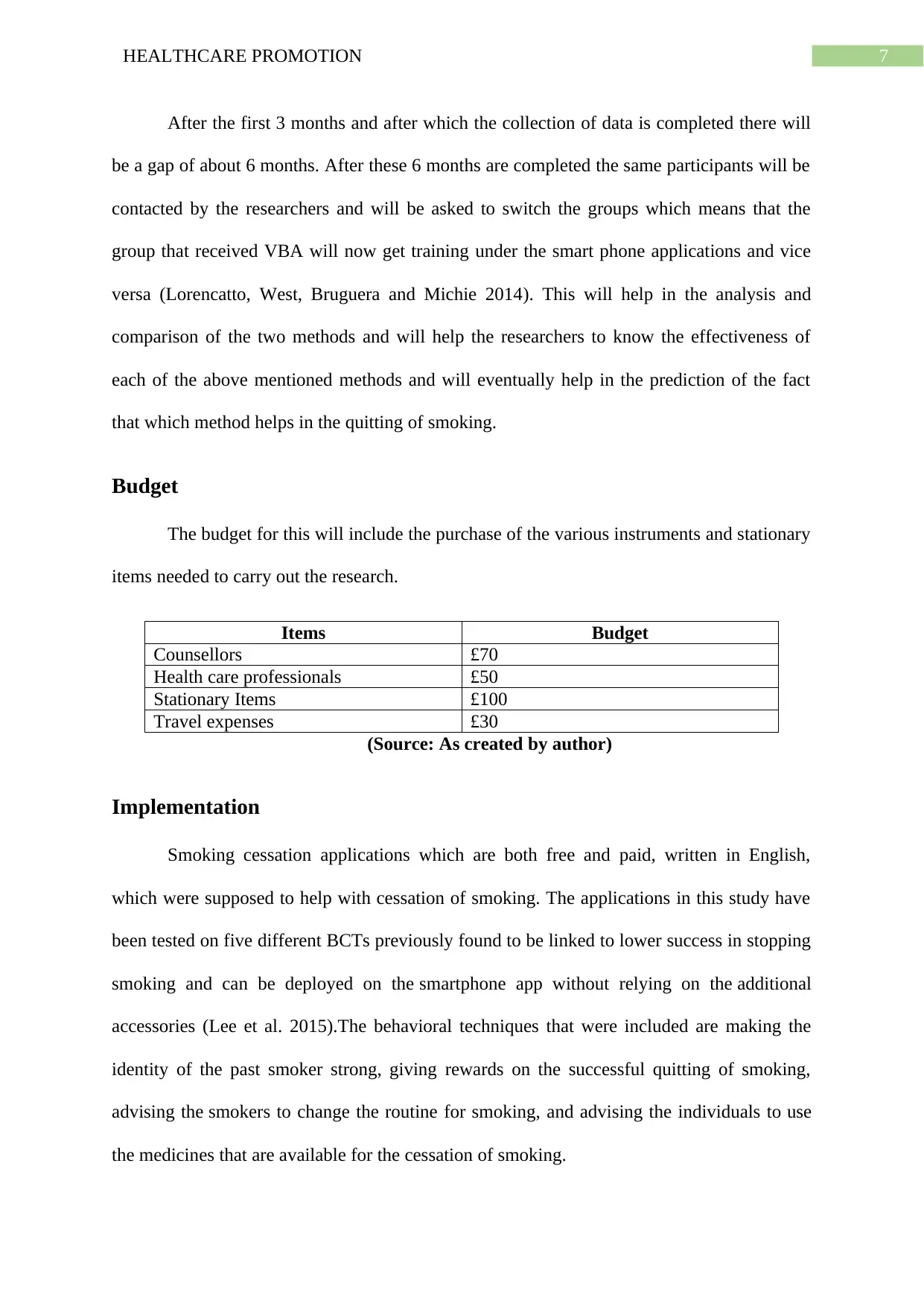
7HEALTHCARE PROMOTION
After the first 3 months and after which the collection of data is completed there will
be a gap of about 6 months. After these 6 months are completed the same participants will be
contacted by the researchers and will be asked to switch the groups which means that the
group that received VBA will now get training under the smart phone applications and vice
versa (Lorencatto, West, Bruguera and Michie 2014). This will help in the analysis and
comparison of the two methods and will help the researchers to know the effectiveness of
each of the above mentioned methods and will eventually help in the prediction of the fact
that which method helps in the quitting of smoking.
Budget
The budget for this will include the purchase of the various instruments and stationary
items needed to carry out the research.
Items Budget
Counsellors £70
Health care professionals £50
Stationary Items £100
Travel expenses £30
(Source: As created by author)
Implementation
Smoking cessation applications which are both free and paid, written in English,
which were supposed to help with cessation of smoking. The applications in this study have
been tested on five different BCTs previously found to be linked to lower success in stopping
smoking and can be deployed on the smartphone app without relying on the additional
accessories (Lee et al. 2015).The behavioral techniques that were included are making the
identity of the past smoker strong, giving rewards on the successful quitting of smoking,
advising the smokers to change the routine for smoking, and advising the individuals to use
the medicines that are available for the cessation of smoking.
After the first 3 months and after which the collection of data is completed there will
be a gap of about 6 months. After these 6 months are completed the same participants will be
contacted by the researchers and will be asked to switch the groups which means that the
group that received VBA will now get training under the smart phone applications and vice
versa (Lorencatto, West, Bruguera and Michie 2014). This will help in the analysis and
comparison of the two methods and will help the researchers to know the effectiveness of
each of the above mentioned methods and will eventually help in the prediction of the fact
that which method helps in the quitting of smoking.
Budget
The budget for this will include the purchase of the various instruments and stationary
items needed to carry out the research.
Items Budget
Counsellors £70
Health care professionals £50
Stationary Items £100
Travel expenses £30
(Source: As created by author)
Implementation
Smoking cessation applications which are both free and paid, written in English,
which were supposed to help with cessation of smoking. The applications in this study have
been tested on five different BCTs previously found to be linked to lower success in stopping
smoking and can be deployed on the smartphone app without relying on the additional
accessories (Lee et al. 2015).The behavioral techniques that were included are making the
identity of the past smoker strong, giving rewards on the successful quitting of smoking,
advising the smokers to change the routine for smoking, and advising the individuals to use
the medicines that are available for the cessation of smoking.
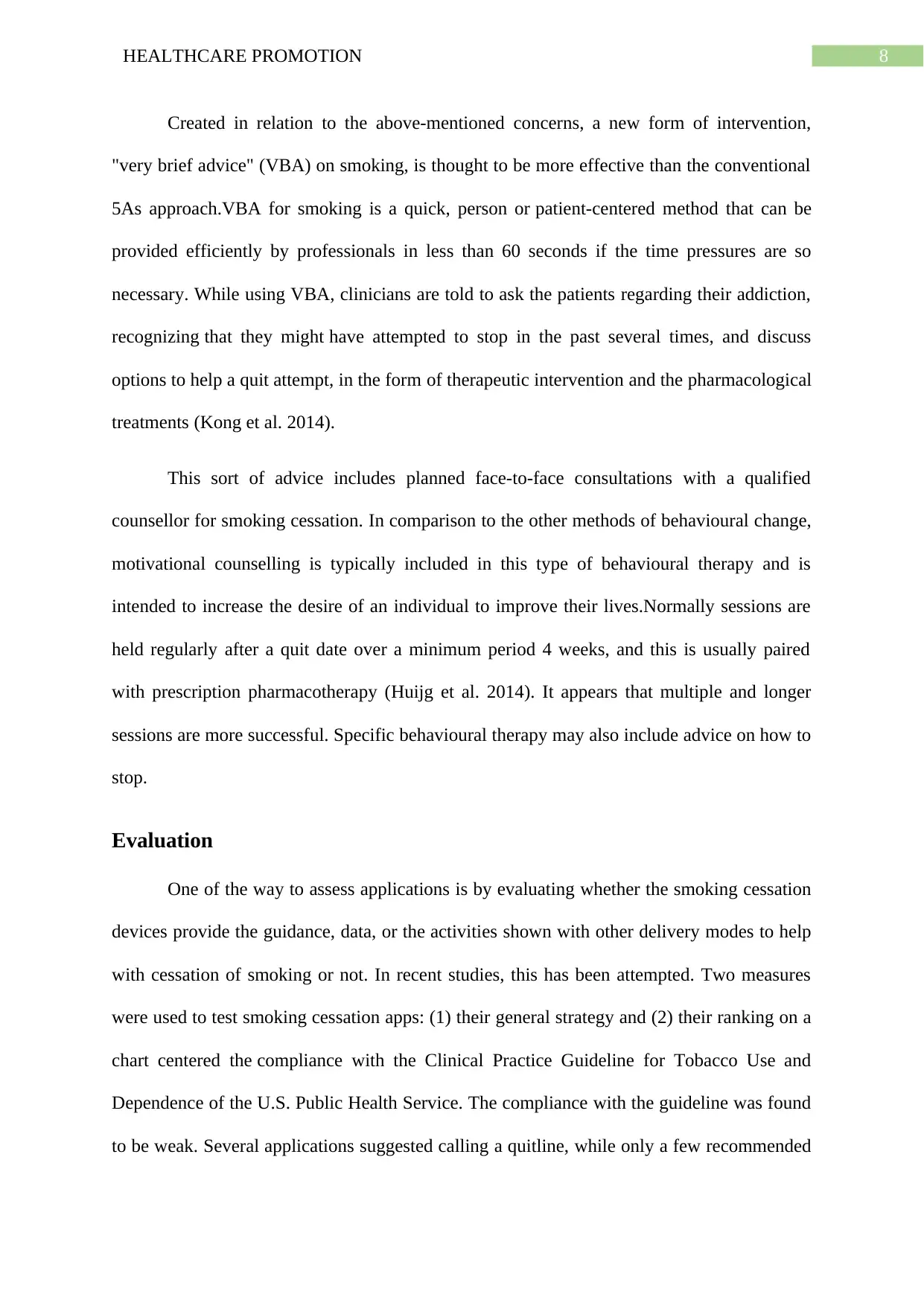
8HEALTHCARE PROMOTION
Created in relation to the above-mentioned concerns, a new form of intervention,
"very brief advice" (VBA) on smoking, is thought to be more effective than the conventional
5As approach.VBA for smoking is a quick, person or patient-centered method that can be
provided efficiently by professionals in less than 60 seconds if the time pressures are so
necessary. While using VBA, clinicians are told to ask the patients regarding their addiction,
recognizing that they might have attempted to stop in the past several times, and discuss
options to help a quit attempt, in the form of therapeutic intervention and the pharmacological
treatments (Kong et al. 2014).
This sort of advice includes planned face-to-face consultations with a qualified
counsellor for smoking cessation. In comparison to the other methods of behavioural change,
motivational counselling is typically included in this type of behavioural therapy and is
intended to increase the desire of an individual to improve their lives.Normally sessions are
held regularly after a quit date over a minimum period 4 weeks, and this is usually paired
with prescription pharmacotherapy (Huijg et al. 2014). It appears that multiple and longer
sessions are more successful. Specific behavioural therapy may also include advice on how to
stop.
Evaluation
One of the way to assess applications is by evaluating whether the smoking cessation
devices provide the guidance, data, or the activities shown with other delivery modes to help
with cessation of smoking or not. In recent studies, this has been attempted. Two measures
were used to test smoking cessation apps: (1) their general strategy and (2) their ranking on a
chart centered the compliance with the Clinical Practice Guideline for Tobacco Use and
Dependence of the U.S. Public Health Service. The compliance with the guideline was found
to be weak. Several applications suggested calling a quitline, while only a few recommended
Created in relation to the above-mentioned concerns, a new form of intervention,
"very brief advice" (VBA) on smoking, is thought to be more effective than the conventional
5As approach.VBA for smoking is a quick, person or patient-centered method that can be
provided efficiently by professionals in less than 60 seconds if the time pressures are so
necessary. While using VBA, clinicians are told to ask the patients regarding their addiction,
recognizing that they might have attempted to stop in the past several times, and discuss
options to help a quit attempt, in the form of therapeutic intervention and the pharmacological
treatments (Kong et al. 2014).
This sort of advice includes planned face-to-face consultations with a qualified
counsellor for smoking cessation. In comparison to the other methods of behavioural change,
motivational counselling is typically included in this type of behavioural therapy and is
intended to increase the desire of an individual to improve their lives.Normally sessions are
held regularly after a quit date over a minimum period 4 weeks, and this is usually paired
with prescription pharmacotherapy (Huijg et al. 2014). It appears that multiple and longer
sessions are more successful. Specific behavioural therapy may also include advice on how to
stop.
Evaluation
One of the way to assess applications is by evaluating whether the smoking cessation
devices provide the guidance, data, or the activities shown with other delivery modes to help
with cessation of smoking or not. In recent studies, this has been attempted. Two measures
were used to test smoking cessation apps: (1) their general strategy and (2) their ranking on a
chart centered the compliance with the Clinical Practice Guideline for Tobacco Use and
Dependence of the U.S. Public Health Service. The compliance with the guideline was found
to be weak. Several applications suggested calling a quitline, while only a few recommended
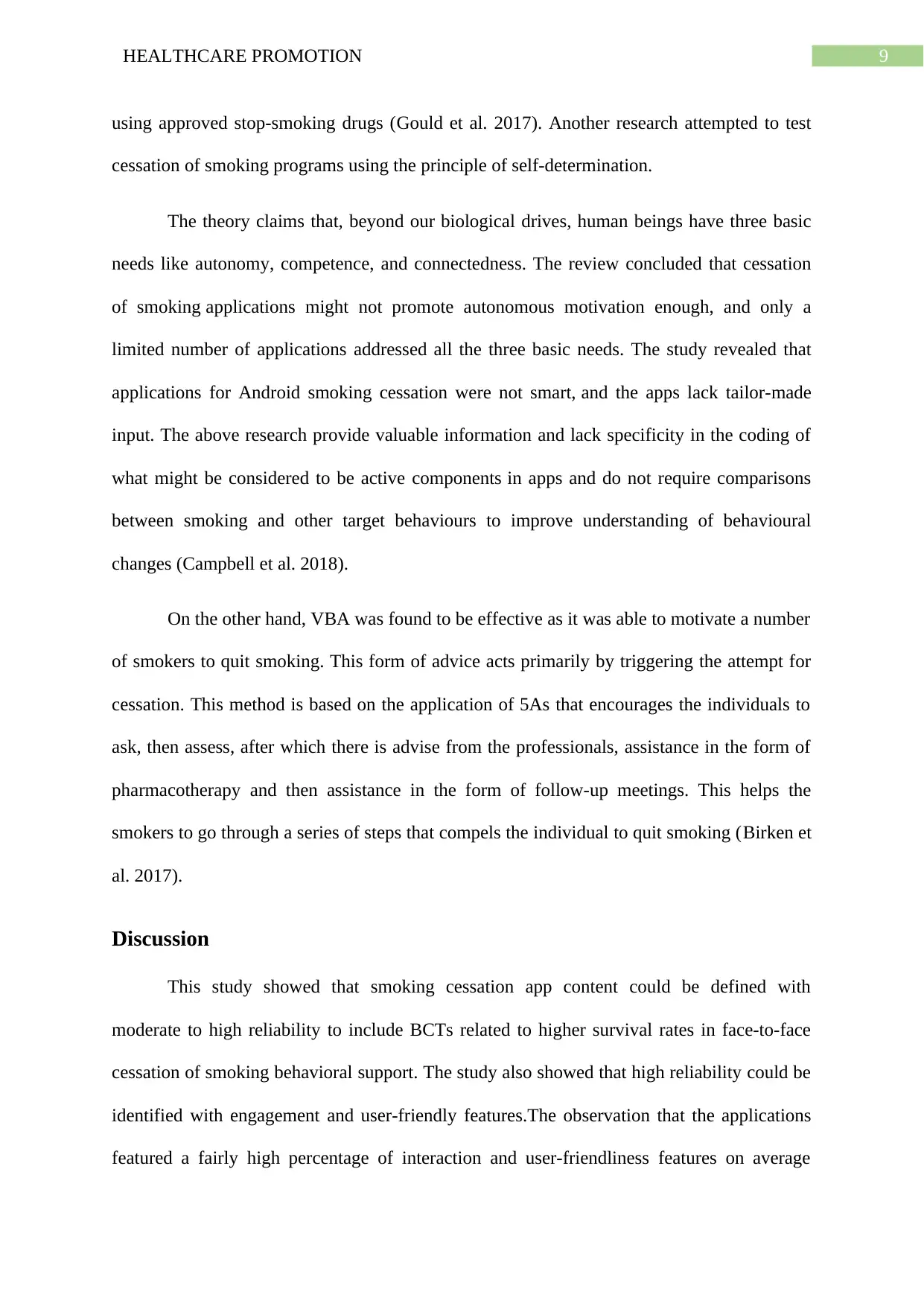
9HEALTHCARE PROMOTION
using approved stop-smoking drugs (Gould et al. 2017). Another research attempted to test
cessation of smoking programs using the principle of self-determination.
The theory claims that, beyond our biological drives, human beings have three basic
needs like autonomy, competence, and connectedness. The review concluded that cessation
of smoking applications might not promote autonomous motivation enough, and only a
limited number of applications addressed all the three basic needs. The study revealed that
applications for Android smoking cessation were not smart, and the apps lack tailor-made
input. The above research provide valuable information and lack specificity in the coding of
what might be considered to be active components in apps and do not require comparisons
between smoking and other target behaviours to improve understanding of behavioural
changes (Campbell et al. 2018).
On the other hand, VBA was found to be effective as it was able to motivate a number
of smokers to quit smoking. This form of advice acts primarily by triggering the attempt for
cessation. This method is based on the application of 5As that encourages the individuals to
ask, then assess, after which there is advise from the professionals, assistance in the form of
pharmacotherapy and then assistance in the form of follow-up meetings. This helps the
smokers to go through a series of steps that compels the individual to quit smoking (Birken et
al. 2017).
Discussion
This study showed that smoking cessation app content could be defined with
moderate to high reliability to include BCTs related to higher survival rates in face-to-face
cessation of smoking behavioral support. The study also showed that high reliability could be
identified with engagement and user-friendly features.The observation that the applications
featured a fairly high percentage of interaction and user-friendliness features on average
using approved stop-smoking drugs (Gould et al. 2017). Another research attempted to test
cessation of smoking programs using the principle of self-determination.
The theory claims that, beyond our biological drives, human beings have three basic
needs like autonomy, competence, and connectedness. The review concluded that cessation
of smoking applications might not promote autonomous motivation enough, and only a
limited number of applications addressed all the three basic needs. The study revealed that
applications for Android smoking cessation were not smart, and the apps lack tailor-made
input. The above research provide valuable information and lack specificity in the coding of
what might be considered to be active components in apps and do not require comparisons
between smoking and other target behaviours to improve understanding of behavioural
changes (Campbell et al. 2018).
On the other hand, VBA was found to be effective as it was able to motivate a number
of smokers to quit smoking. This form of advice acts primarily by triggering the attempt for
cessation. This method is based on the application of 5As that encourages the individuals to
ask, then assess, after which there is advise from the professionals, assistance in the form of
pharmacotherapy and then assistance in the form of follow-up meetings. This helps the
smokers to go through a series of steps that compels the individual to quit smoking (Birken et
al. 2017).
Discussion
This study showed that smoking cessation app content could be defined with
moderate to high reliability to include BCTs related to higher survival rates in face-to-face
cessation of smoking behavioral support. The study also showed that high reliability could be
identified with engagement and user-friendly features.The observation that the applications
featured a fairly high percentage of interaction and user-friendliness features on average
Secure Best Marks with AI Grader
Need help grading? Try our AI Grader for instant feedback on your assignments.
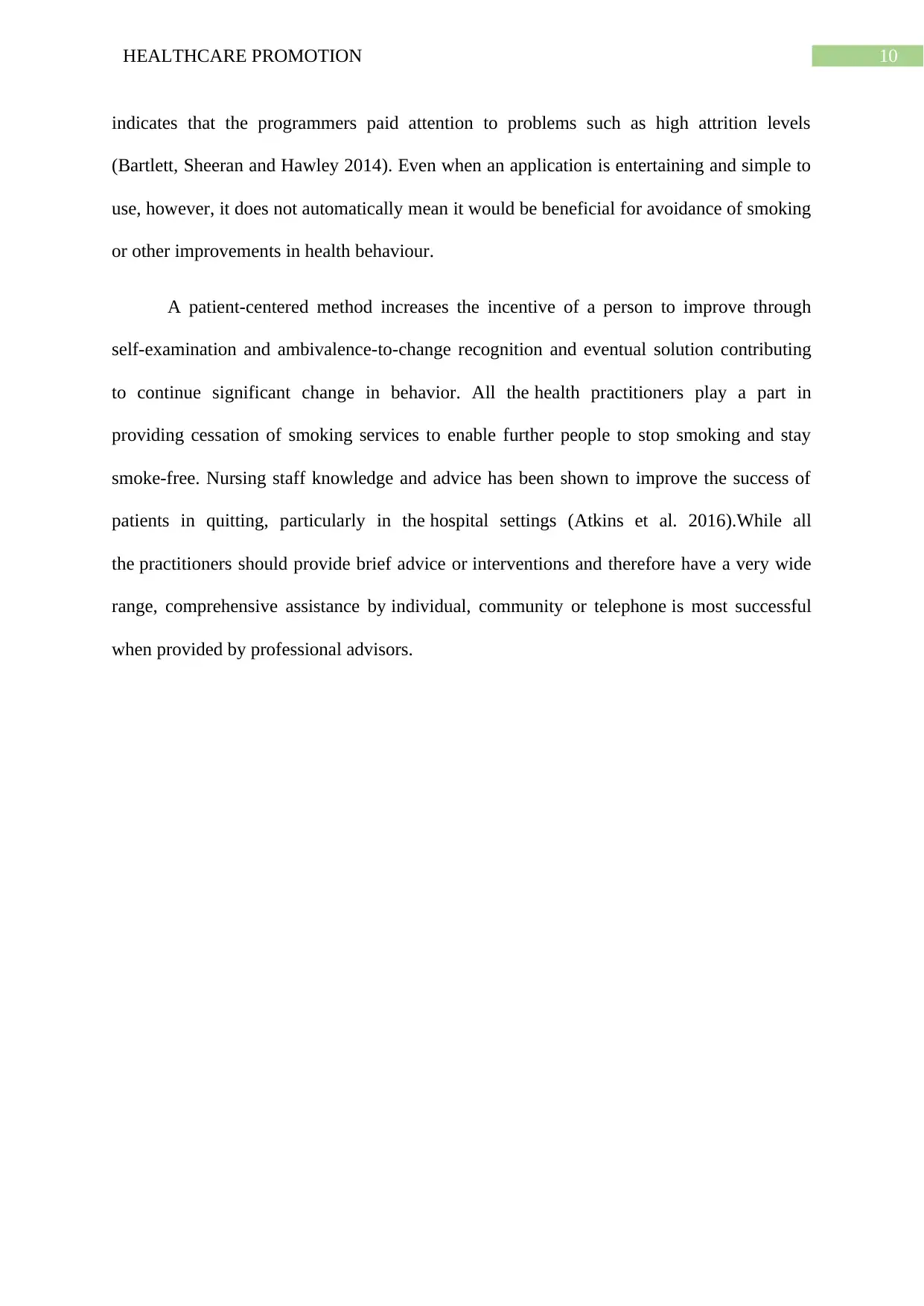
10HEALTHCARE PROMOTION
indicates that the programmers paid attention to problems such as high attrition levels
(Bartlett, Sheeran and Hawley 2014). Even when an application is entertaining and simple to
use, however, it does not automatically mean it would be beneficial for avoidance of smoking
or other improvements in health behaviour.
A patient-centered method increases the incentive of a person to improve through
self-examination and ambivalence-to-change recognition and eventual solution contributing
to continue significant change in behavior. All the health practitioners play a part in
providing cessation of smoking services to enable further people to stop smoking and stay
smoke-free. Nursing staff knowledge and advice has been shown to improve the success of
patients in quitting, particularly in the hospital settings (Atkins et al. 2016).While all
the practitioners should provide brief advice or interventions and therefore have a very wide
range, comprehensive assistance by individual, community or telephone is most successful
when provided by professional advisors.
indicates that the programmers paid attention to problems such as high attrition levels
(Bartlett, Sheeran and Hawley 2014). Even when an application is entertaining and simple to
use, however, it does not automatically mean it would be beneficial for avoidance of smoking
or other improvements in health behaviour.
A patient-centered method increases the incentive of a person to improve through
self-examination and ambivalence-to-change recognition and eventual solution contributing
to continue significant change in behavior. All the health practitioners play a part in
providing cessation of smoking services to enable further people to stop smoking and stay
smoke-free. Nursing staff knowledge and advice has been shown to improve the success of
patients in quitting, particularly in the hospital settings (Atkins et al. 2016).While all
the practitioners should provide brief advice or interventions and therefore have a very wide
range, comprehensive assistance by individual, community or telephone is most successful
when provided by professional advisors.
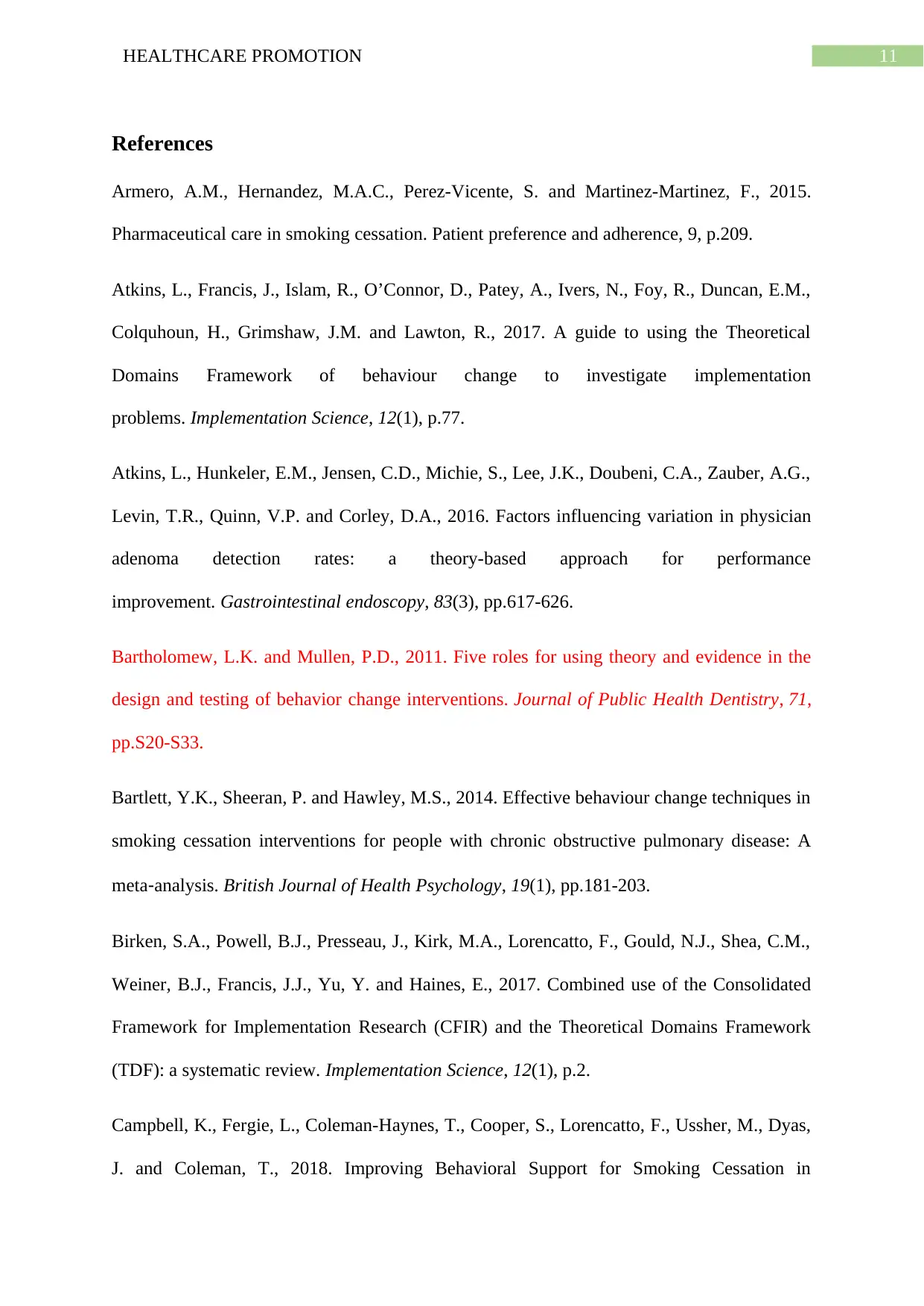
11HEALTHCARE PROMOTION
References
Armero, A.M., Hernandez, M.A.C., Perez-Vicente, S. and Martinez-Martinez, F., 2015.
Pharmaceutical care in smoking cessation. Patient preference and adherence, 9, p.209.
Atkins, L., Francis, J., Islam, R., O’Connor, D., Patey, A., Ivers, N., Foy, R., Duncan, E.M.,
Colquhoun, H., Grimshaw, J.M. and Lawton, R., 2017. A guide to using the Theoretical
Domains Framework of behaviour change to investigate implementation
problems. Implementation Science, 12(1), p.77.
Atkins, L., Hunkeler, E.M., Jensen, C.D., Michie, S., Lee, J.K., Doubeni, C.A., Zauber, A.G.,
Levin, T.R., Quinn, V.P. and Corley, D.A., 2016. Factors influencing variation in physician
adenoma detection rates: a theory-based approach for performance
improvement. Gastrointestinal endoscopy, 83(3), pp.617-626.
Bartholomew, L.K. and Mullen, P.D., 2011. Five roles for using theory and evidence in the
design and testing of behavior change interventions. Journal of Public Health Dentistry, 71,
pp.S20-S33.
Bartlett, Y.K., Sheeran, P. and Hawley, M.S., 2014. Effective behaviour change techniques in
smoking cessation interventions for people with chronic obstructive pulmonary disease: A
meta‐analysis. British Journal of Health Psychology, 19(1), pp.181-203.
Birken, S.A., Powell, B.J., Presseau, J., Kirk, M.A., Lorencatto, F., Gould, N.J., Shea, C.M.,
Weiner, B.J., Francis, J.J., Yu, Y. and Haines, E., 2017. Combined use of the Consolidated
Framework for Implementation Research (CFIR) and the Theoretical Domains Framework
(TDF): a systematic review. Implementation Science, 12(1), p.2.
Campbell, K., Fergie, L., Coleman-Haynes, T., Cooper, S., Lorencatto, F., Ussher, M., Dyas,
J. and Coleman, T., 2018. Improving Behavioral Support for Smoking Cessation in
References
Armero, A.M., Hernandez, M.A.C., Perez-Vicente, S. and Martinez-Martinez, F., 2015.
Pharmaceutical care in smoking cessation. Patient preference and adherence, 9, p.209.
Atkins, L., Francis, J., Islam, R., O’Connor, D., Patey, A., Ivers, N., Foy, R., Duncan, E.M.,
Colquhoun, H., Grimshaw, J.M. and Lawton, R., 2017. A guide to using the Theoretical
Domains Framework of behaviour change to investigate implementation
problems. Implementation Science, 12(1), p.77.
Atkins, L., Hunkeler, E.M., Jensen, C.D., Michie, S., Lee, J.K., Doubeni, C.A., Zauber, A.G.,
Levin, T.R., Quinn, V.P. and Corley, D.A., 2016. Factors influencing variation in physician
adenoma detection rates: a theory-based approach for performance
improvement. Gastrointestinal endoscopy, 83(3), pp.617-626.
Bartholomew, L.K. and Mullen, P.D., 2011. Five roles for using theory and evidence in the
design and testing of behavior change interventions. Journal of Public Health Dentistry, 71,
pp.S20-S33.
Bartlett, Y.K., Sheeran, P. and Hawley, M.S., 2014. Effective behaviour change techniques in
smoking cessation interventions for people with chronic obstructive pulmonary disease: A
meta‐analysis. British Journal of Health Psychology, 19(1), pp.181-203.
Birken, S.A., Powell, B.J., Presseau, J., Kirk, M.A., Lorencatto, F., Gould, N.J., Shea, C.M.,
Weiner, B.J., Francis, J.J., Yu, Y. and Haines, E., 2017. Combined use of the Consolidated
Framework for Implementation Research (CFIR) and the Theoretical Domains Framework
(TDF): a systematic review. Implementation Science, 12(1), p.2.
Campbell, K., Fergie, L., Coleman-Haynes, T., Cooper, S., Lorencatto, F., Ussher, M., Dyas,
J. and Coleman, T., 2018. Improving Behavioral Support for Smoking Cessation in
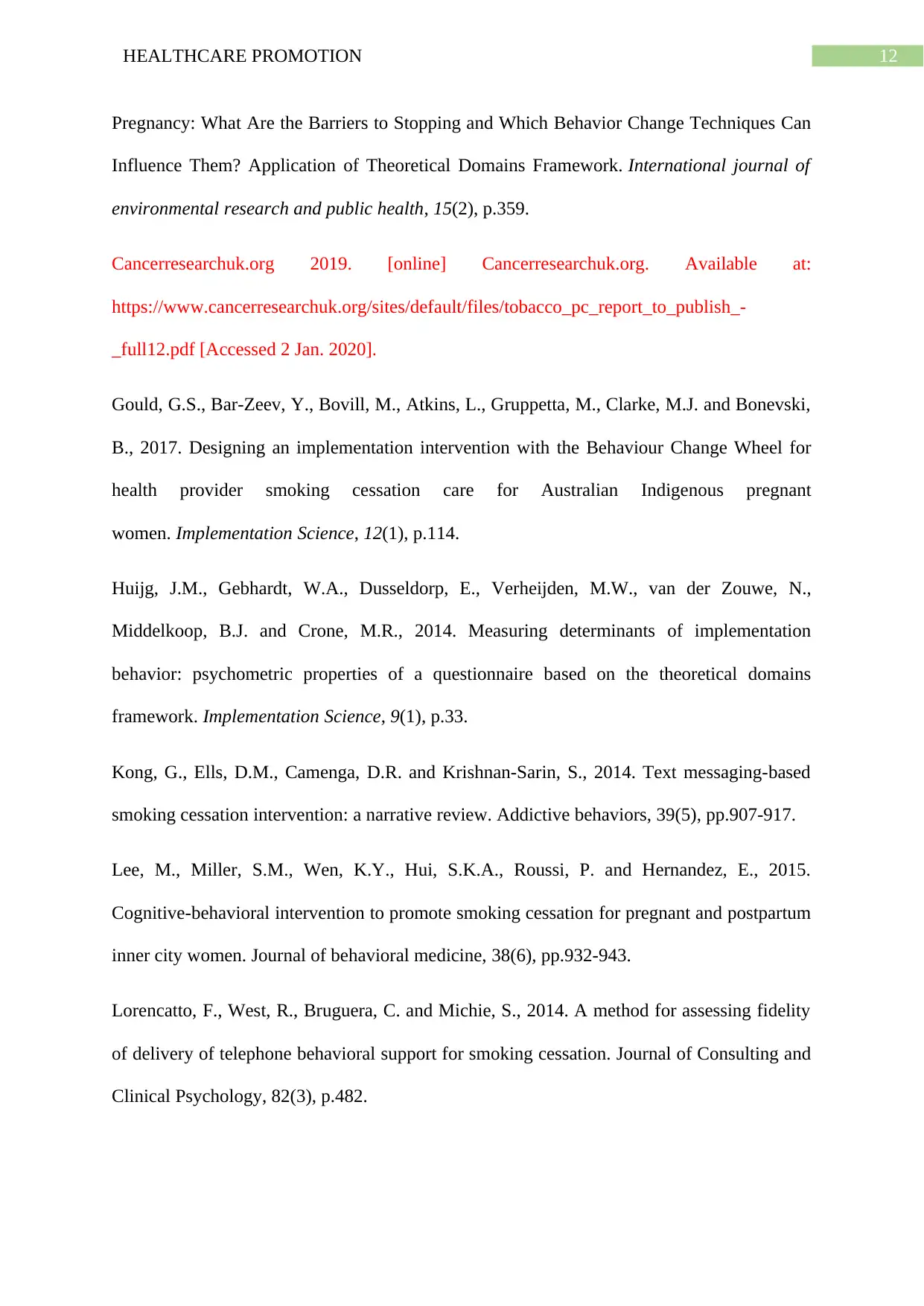
12HEALTHCARE PROMOTION
Pregnancy: What Are the Barriers to Stopping and Which Behavior Change Techniques Can
Influence Them? Application of Theoretical Domains Framework. International journal of
environmental research and public health, 15(2), p.359.
Cancerresearchuk.org 2019. [online] Cancerresearchuk.org. Available at:
https://www.cancerresearchuk.org/sites/default/files/tobacco_pc_report_to_publish_-
_full12.pdf [Accessed 2 Jan. 2020].
Gould, G.S., Bar-Zeev, Y., Bovill, M., Atkins, L., Gruppetta, M., Clarke, M.J. and Bonevski,
B., 2017. Designing an implementation intervention with the Behaviour Change Wheel for
health provider smoking cessation care for Australian Indigenous pregnant
women. Implementation Science, 12(1), p.114.
Huijg, J.M., Gebhardt, W.A., Dusseldorp, E., Verheijden, M.W., van der Zouwe, N.,
Middelkoop, B.J. and Crone, M.R., 2014. Measuring determinants of implementation
behavior: psychometric properties of a questionnaire based on the theoretical domains
framework. Implementation Science, 9(1), p.33.
Kong, G., Ells, D.M., Camenga, D.R. and Krishnan-Sarin, S., 2014. Text messaging-based
smoking cessation intervention: a narrative review. Addictive behaviors, 39(5), pp.907-917.
Lee, M., Miller, S.M., Wen, K.Y., Hui, S.K.A., Roussi, P. and Hernandez, E., 2015.
Cognitive-behavioral intervention to promote smoking cessation for pregnant and postpartum
inner city women. Journal of behavioral medicine, 38(6), pp.932-943.
Lorencatto, F., West, R., Bruguera, C. and Michie, S., 2014. A method for assessing fidelity
of delivery of telephone behavioral support for smoking cessation. Journal of Consulting and
Clinical Psychology, 82(3), p.482.
Pregnancy: What Are the Barriers to Stopping and Which Behavior Change Techniques Can
Influence Them? Application of Theoretical Domains Framework. International journal of
environmental research and public health, 15(2), p.359.
Cancerresearchuk.org 2019. [online] Cancerresearchuk.org. Available at:
https://www.cancerresearchuk.org/sites/default/files/tobacco_pc_report_to_publish_-
_full12.pdf [Accessed 2 Jan. 2020].
Gould, G.S., Bar-Zeev, Y., Bovill, M., Atkins, L., Gruppetta, M., Clarke, M.J. and Bonevski,
B., 2017. Designing an implementation intervention with the Behaviour Change Wheel for
health provider smoking cessation care for Australian Indigenous pregnant
women. Implementation Science, 12(1), p.114.
Huijg, J.M., Gebhardt, W.A., Dusseldorp, E., Verheijden, M.W., van der Zouwe, N.,
Middelkoop, B.J. and Crone, M.R., 2014. Measuring determinants of implementation
behavior: psychometric properties of a questionnaire based on the theoretical domains
framework. Implementation Science, 9(1), p.33.
Kong, G., Ells, D.M., Camenga, D.R. and Krishnan-Sarin, S., 2014. Text messaging-based
smoking cessation intervention: a narrative review. Addictive behaviors, 39(5), pp.907-917.
Lee, M., Miller, S.M., Wen, K.Y., Hui, S.K.A., Roussi, P. and Hernandez, E., 2015.
Cognitive-behavioral intervention to promote smoking cessation for pregnant and postpartum
inner city women. Journal of behavioral medicine, 38(6), pp.932-943.
Lorencatto, F., West, R., Bruguera, C. and Michie, S., 2014. A method for assessing fidelity
of delivery of telephone behavioral support for smoking cessation. Journal of Consulting and
Clinical Psychology, 82(3), p.482.
Paraphrase This Document
Need a fresh take? Get an instant paraphrase of this document with our AI Paraphraser
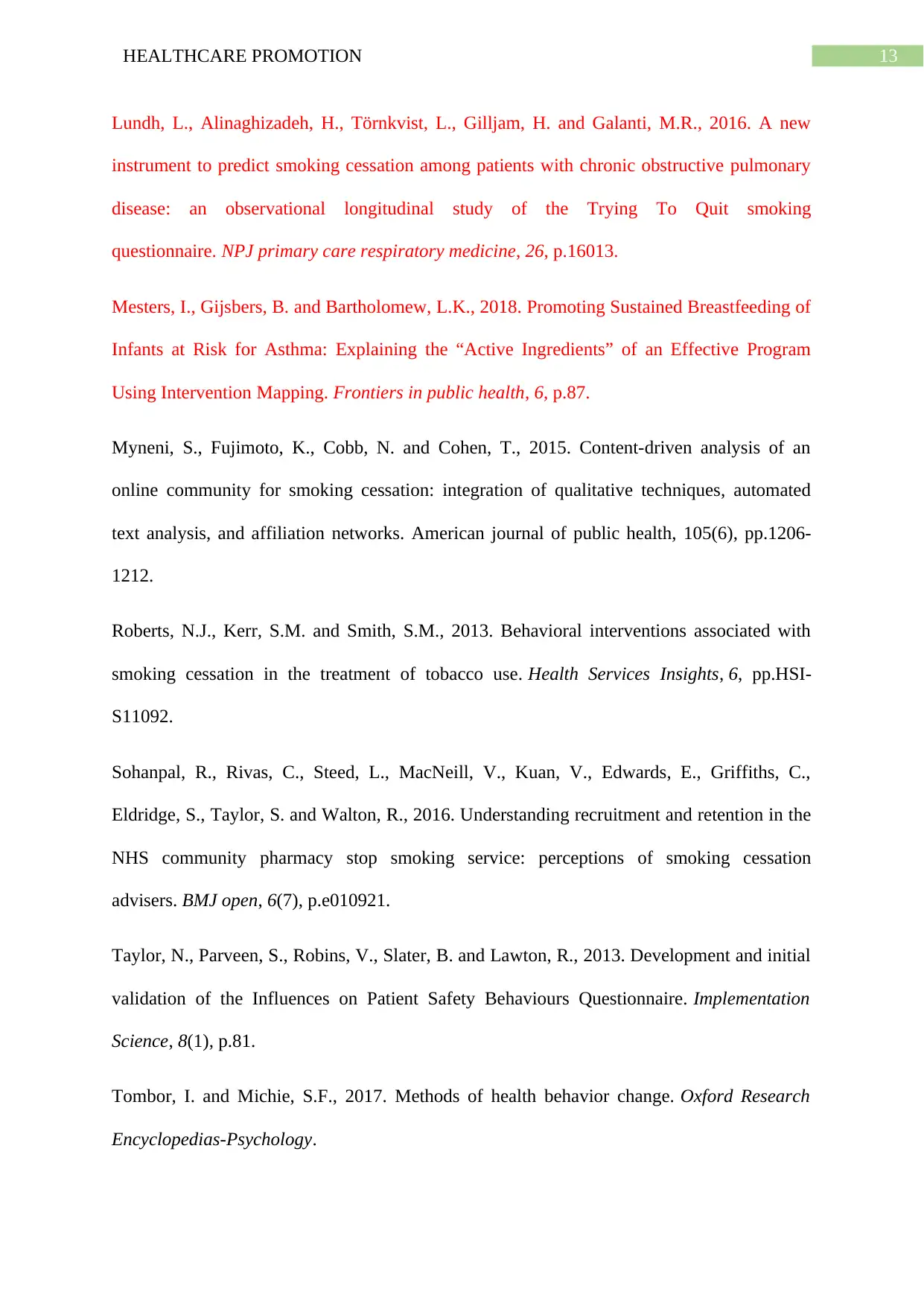
13HEALTHCARE PROMOTION
Lundh, L., Alinaghizadeh, H., Törnkvist, L., Gilljam, H. and Galanti, M.R., 2016. A new
instrument to predict smoking cessation among patients with chronic obstructive pulmonary
disease: an observational longitudinal study of the Trying To Quit smoking
questionnaire. NPJ primary care respiratory medicine, 26, p.16013.
Mesters, I., Gijsbers, B. and Bartholomew, L.K., 2018. Promoting Sustained Breastfeeding of
Infants at Risk for Asthma: Explaining the “Active Ingredients” of an Effective Program
Using Intervention Mapping. Frontiers in public health, 6, p.87.
Myneni, S., Fujimoto, K., Cobb, N. and Cohen, T., 2015. Content-driven analysis of an
online community for smoking cessation: integration of qualitative techniques, automated
text analysis, and affiliation networks. American journal of public health, 105(6), pp.1206-
1212.
Roberts, N.J., Kerr, S.M. and Smith, S.M., 2013. Behavioral interventions associated with
smoking cessation in the treatment of tobacco use. Health Services Insights, 6, pp.HSI-
S11092.
Sohanpal, R., Rivas, C., Steed, L., MacNeill, V., Kuan, V., Edwards, E., Griffiths, C.,
Eldridge, S., Taylor, S. and Walton, R., 2016. Understanding recruitment and retention in the
NHS community pharmacy stop smoking service: perceptions of smoking cessation
advisers. BMJ open, 6(7), p.e010921.
Taylor, N., Parveen, S., Robins, V., Slater, B. and Lawton, R., 2013. Development and initial
validation of the Influences on Patient Safety Behaviours Questionnaire. Implementation
Science, 8(1), p.81.
Tombor, I. and Michie, S.F., 2017. Methods of health behavior change. Oxford Research
Encyclopedias-Psychology.
Lundh, L., Alinaghizadeh, H., Törnkvist, L., Gilljam, H. and Galanti, M.R., 2016. A new
instrument to predict smoking cessation among patients with chronic obstructive pulmonary
disease: an observational longitudinal study of the Trying To Quit smoking
questionnaire. NPJ primary care respiratory medicine, 26, p.16013.
Mesters, I., Gijsbers, B. and Bartholomew, L.K., 2018. Promoting Sustained Breastfeeding of
Infants at Risk for Asthma: Explaining the “Active Ingredients” of an Effective Program
Using Intervention Mapping. Frontiers in public health, 6, p.87.
Myneni, S., Fujimoto, K., Cobb, N. and Cohen, T., 2015. Content-driven analysis of an
online community for smoking cessation: integration of qualitative techniques, automated
text analysis, and affiliation networks. American journal of public health, 105(6), pp.1206-
1212.
Roberts, N.J., Kerr, S.M. and Smith, S.M., 2013. Behavioral interventions associated with
smoking cessation in the treatment of tobacco use. Health Services Insights, 6, pp.HSI-
S11092.
Sohanpal, R., Rivas, C., Steed, L., MacNeill, V., Kuan, V., Edwards, E., Griffiths, C.,
Eldridge, S., Taylor, S. and Walton, R., 2016. Understanding recruitment and retention in the
NHS community pharmacy stop smoking service: perceptions of smoking cessation
advisers. BMJ open, 6(7), p.e010921.
Taylor, N., Parveen, S., Robins, V., Slater, B. and Lawton, R., 2013. Development and initial
validation of the Influences on Patient Safety Behaviours Questionnaire. Implementation
Science, 8(1), p.81.
Tombor, I. and Michie, S.F., 2017. Methods of health behavior change. Oxford Research
Encyclopedias-Psychology.
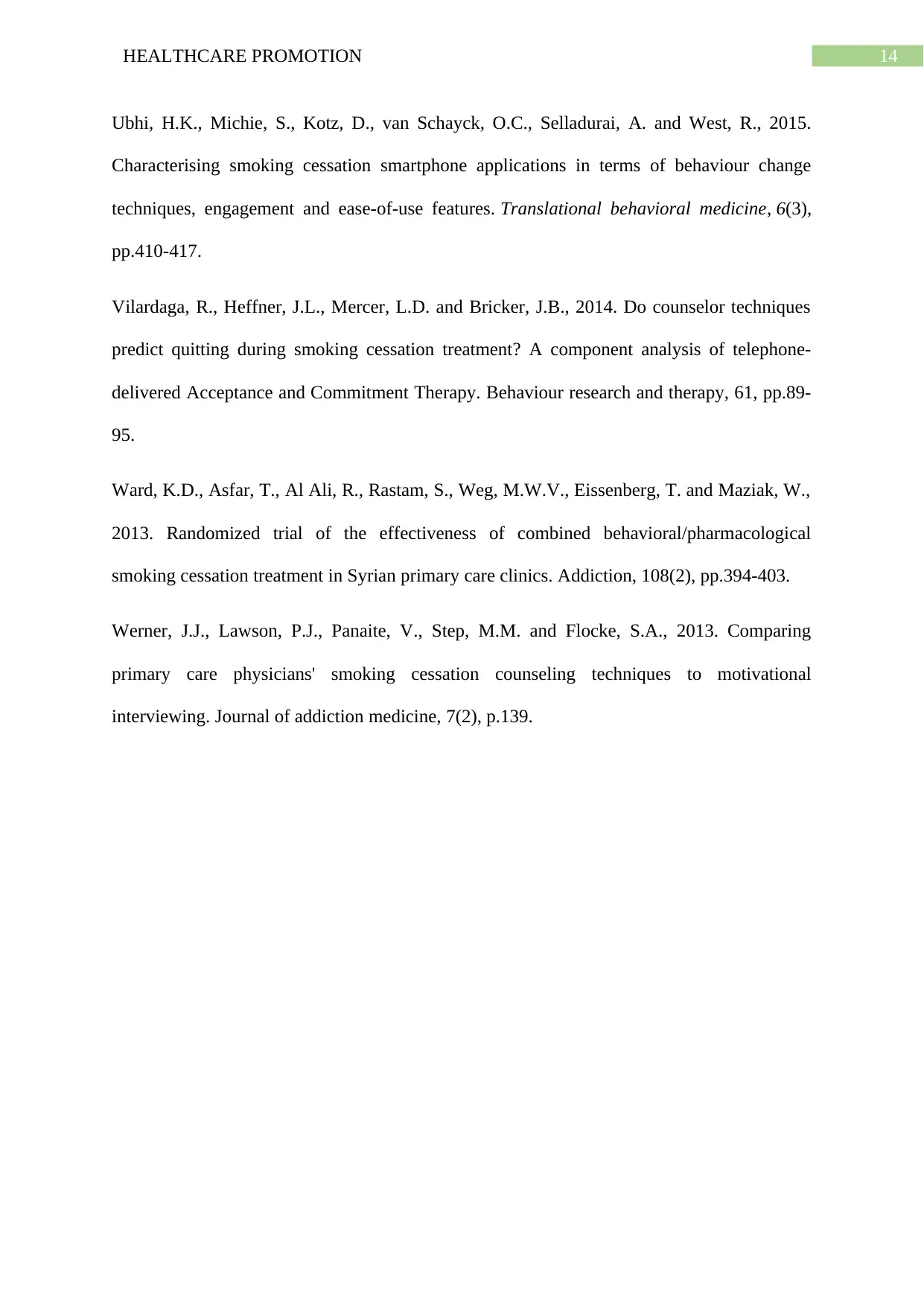
14HEALTHCARE PROMOTION
Ubhi, H.K., Michie, S., Kotz, D., van Schayck, O.C., Selladurai, A. and West, R., 2015.
Characterising smoking cessation smartphone applications in terms of behaviour change
techniques, engagement and ease-of-use features. Translational behavioral medicine, 6(3),
pp.410-417.
Vilardaga, R., Heffner, J.L., Mercer, L.D. and Bricker, J.B., 2014. Do counselor techniques
predict quitting during smoking cessation treatment? A component analysis of telephone-
delivered Acceptance and Commitment Therapy. Behaviour research and therapy, 61, pp.89-
95.
Ward, K.D., Asfar, T., Al Ali, R., Rastam, S., Weg, M.W.V., Eissenberg, T. and Maziak, W.,
2013. Randomized trial of the effectiveness of combined behavioral/pharmacological
smoking cessation treatment in Syrian primary care clinics. Addiction, 108(2), pp.394-403.
Werner, J.J., Lawson, P.J., Panaite, V., Step, M.M. and Flocke, S.A., 2013. Comparing
primary care physicians' smoking cessation counseling techniques to motivational
interviewing. Journal of addiction medicine, 7(2), p.139.
Ubhi, H.K., Michie, S., Kotz, D., van Schayck, O.C., Selladurai, A. and West, R., 2015.
Characterising smoking cessation smartphone applications in terms of behaviour change
techniques, engagement and ease-of-use features. Translational behavioral medicine, 6(3),
pp.410-417.
Vilardaga, R., Heffner, J.L., Mercer, L.D. and Bricker, J.B., 2014. Do counselor techniques
predict quitting during smoking cessation treatment? A component analysis of telephone-
delivered Acceptance and Commitment Therapy. Behaviour research and therapy, 61, pp.89-
95.
Ward, K.D., Asfar, T., Al Ali, R., Rastam, S., Weg, M.W.V., Eissenberg, T. and Maziak, W.,
2013. Randomized trial of the effectiveness of combined behavioral/pharmacological
smoking cessation treatment in Syrian primary care clinics. Addiction, 108(2), pp.394-403.
Werner, J.J., Lawson, P.J., Panaite, V., Step, M.M. and Flocke, S.A., 2013. Comparing
primary care physicians' smoking cessation counseling techniques to motivational
interviewing. Journal of addiction medicine, 7(2), p.139.
1 out of 15
Related Documents
Your All-in-One AI-Powered Toolkit for Academic Success.
+13062052269
info@desklib.com
Available 24*7 on WhatsApp / Email
![[object Object]](/_next/static/media/star-bottom.7253800d.svg)
Unlock your academic potential
© 2024 | Zucol Services PVT LTD | All rights reserved.





